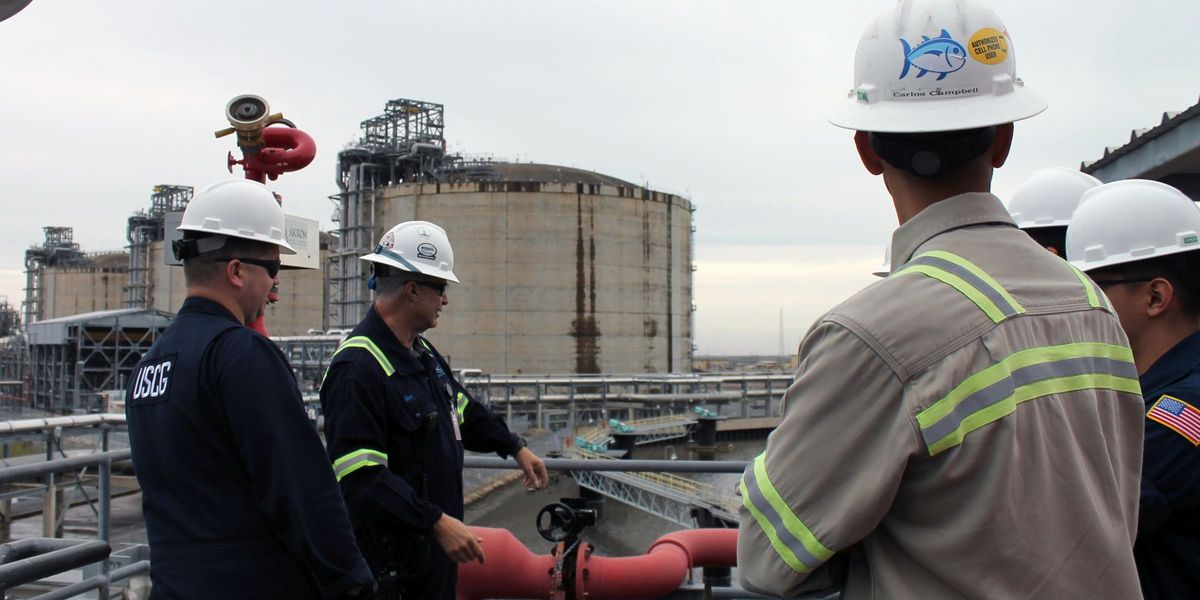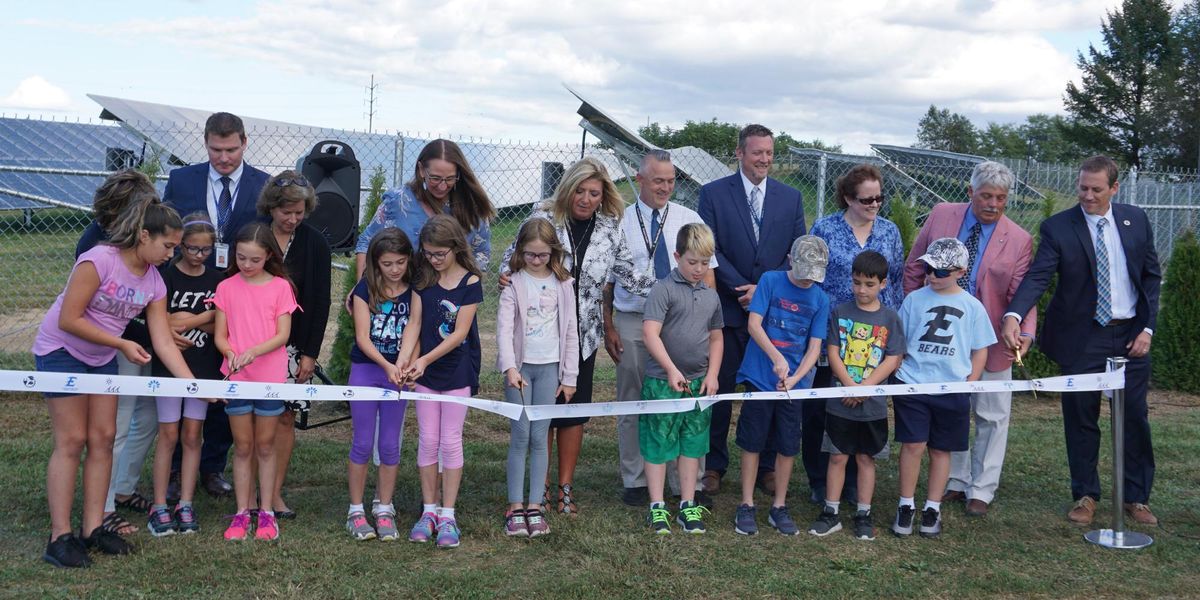
Solar power at Pennsylvania schools doubled during the pandemic
“If this growth continues, schools could set Pennsylvania up as a clean energy leader and not just the fossil fuels we’re known for.”
NORTH BRADDOCK, Penn.—On Wednesday evening, 10th grader Abby Wypych stood in front of Woodland Hills School District’s board and urged them to approve a feasibility study on installing solar panels.
“Woodland Hills has provided me with many opportunities to get involved with climate action, which I’m very passionate about,” she said. “As a student with severe asthma, I’m also very concerned about the poor air quality in our region.”
Wypych and her co-presenter Lauren Palamara, a youth educator for the climate advocacy nonprofit Communitopia, reminded the board that thanks to student advocacy, Woodland Hills became the first school district in Pennsylvania to pass a climate resolution in 2020. With a goal of having net-zero emissions by 2050, the district has helped educators create climate change lessons for their classrooms, established a climate-friendly food and gardening program, improved recycling and energy efficiency in school buildings, and students hosted the region’s first youth climate action summit. In 2021, the district won a national “Best of Green Schools Award” from the U.S. Green Building Council.
“How do we continue to champion this phenomenal work?” Palamara asked. “Imagine our next news headlines if Woodland Hills takes steps toward becoming a regional leader in solar power.”
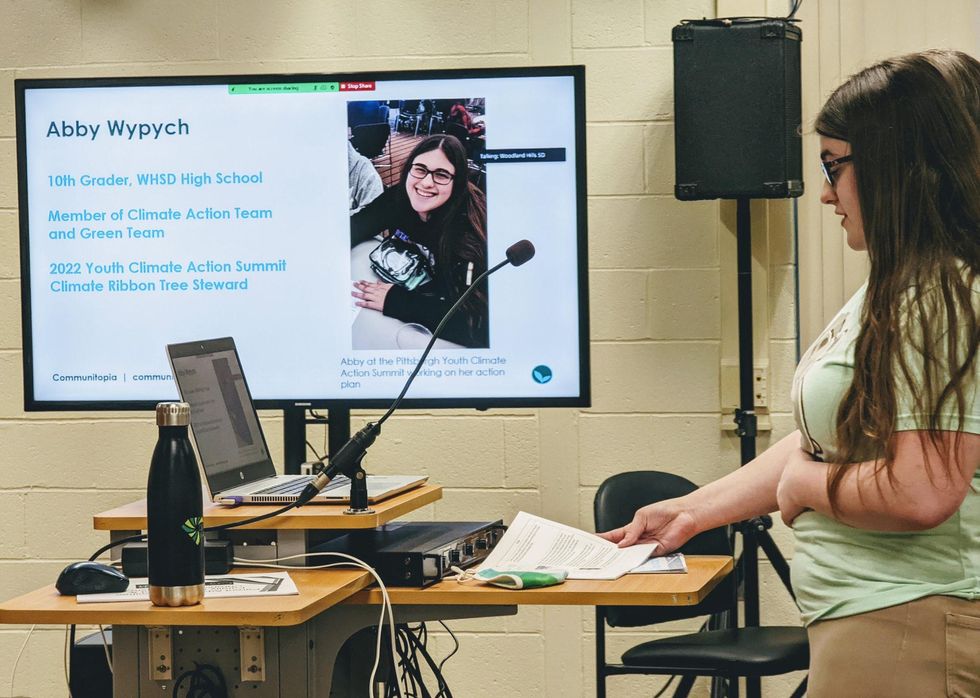
Abby Wypych presents to the Woodland Hills School Board, urging them to move forward with a proposed solar power project. (Credit: Kristina Marusic)
The pitch was effective: The school board voted to accept a letter of intent from solar developer BAI Group. As a next step, they’ll review the company’s proposal to conduct a solar feasibility study for the district.
Woodland Hills is not alone. The number of K-12 schools using solar power in Pennsylvania doubled from 2020-2021, according to a report published today by Generation180, a clean energy nonprofit.
The 108 schools using solar energy in the state represent nearly 5% of all K-12 students in the state (about 90,000 students), and about 2% of all Pennsylvania schools.
“If this growth continues, schools could set Pennsylvania up as a clean energy leader and not just the fossil fuels we’re known for,” Shannon Crooker, the Pennsylvania director at Generation180, told EHN.
In recent years, energy costs increased while the cost of solar panels decreased. According to Generation180’s report, a majority of solar projects at Pennsylvania schools were installed in low-income districts at little to no upfront cost, enabling schools to start saving money immediately.
“We’ve been able to put the money we’re saving on energy toward teacher resources and curriculum materials,” Joe Stroup, the district superintendent for Midd-West School District, which has the largest school district solar array in Pennsylvania, told EHN. “It’s also good for the community because it takes some of the burden of taxes off people in the district.”
Midd-West School District in Middleburg is located in rural central Pennsylvania. In 2019 the district began installation of its solar array, which covers 7.25 acres divided between two school properties and creates up to 2.56 megawatts of solar power. Since the system went online in 2020, the district has generated 90%-95% of the school district’s power, which is expected to reduce its electricity bill by $9 million over 40 years.Most of the schools that have installed solar panels are in the central and eastern parts of the state, with just a handful of projects in western Pennsylvania. Historically, energy costs have been low for schools in the western half of the state, but that’s beginning to change as energy rates increase statewide.
Generation180 has helped schools across the country switch to solar power. A 2020 nationwide report by the group found that the number of K-12 schools in the U.S. using solar power increased by roughly 81% from 2014-2020, and that more than 5.3 million kids and teens attend schools using solar energy. Generation180 is officially launching its Pennsylvania program with the publication of the new report on solar-powered schools in the state, and hopes to help additional school districts switch to solar with free technical assistance and resources.
“There’s a misconception in western Pennsylvania that we can’t go solar because it’s so overcast,” said Crooker. She noted that Pittsburgh’s weather is often compared to rainy Seattle, which is home to the greenest commercial building in the world, the world’s first net-zero energy high-rise apartment building, and the world’s first net-zero energy arena — all of which rely on solar energy.
Palamara hopes Woodland Hills will help lead the way. “I think this district could be a– model in the region for solar-powered schools,” she said.
Low installation costs
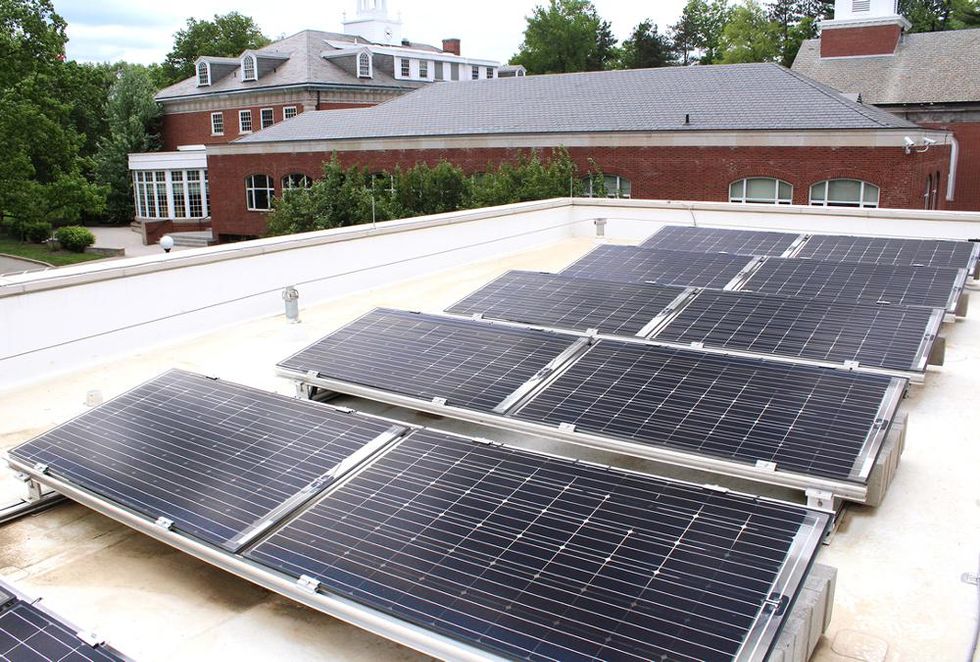
Solar panels at Shady Side Academy in Pittsburgh, Pennsylvania. (Credit: Scalo Solar)
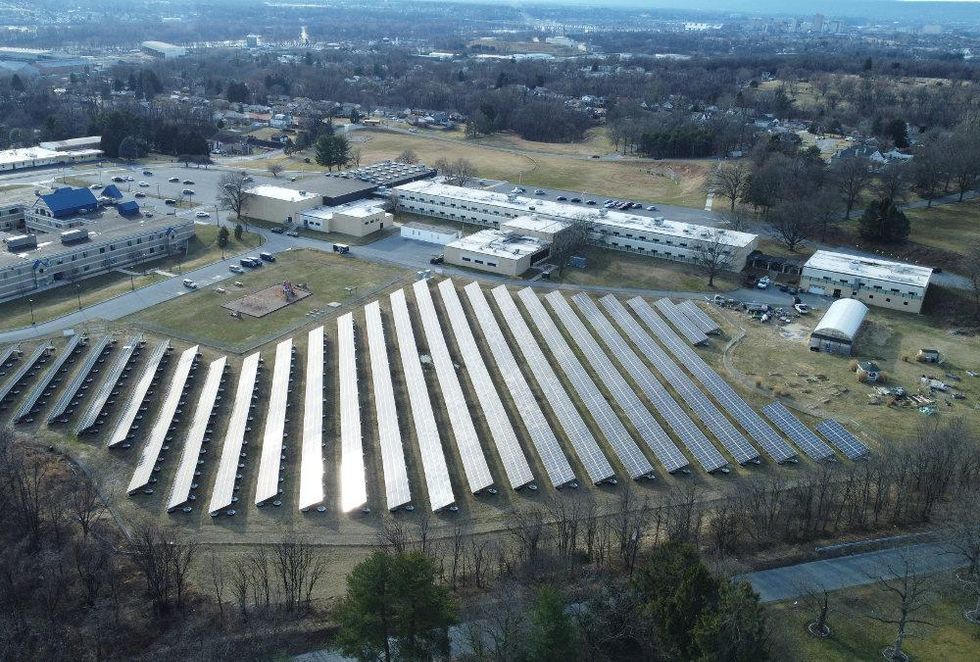
Solar array at Steelton-Highspire School District
in Harrisburg, Pennsylvania. (Credit: McClure Company)
Pennsylvania is one of 29 states that allows “third-party ownership” of solar arrays, which enables a solar developer to pay for, install, and maintain a solar energy system on a property owned by someone else (such as a school district), then sell the property owner the power generated at a discounted price.
Most school districts aren’t eligible for clean energy tax incentives because they’re public entities, but privately owned solar companies that install solar panels on schools receive substantial tax credits, making the relationship beneficial for both parties.
Nationwide, roughly 79% of the solar energy installed at schools from 2015-2020 was financed this way, according to Generation180, and in Pennsylvania, about 66% of existing school solar projects have been paid for this way. Most of the Pennsylvania schools with solar qualify for some sort of Title 1 assistance, meaning a significant portion of their students are from low-income households.
“I think many people assume solar is too expensive,” Tish Tablan, program director at Generation180, told EHN. “Many Pennsylvania schools in low-income areas have already used third-party ownership to go solar with no upfront costs.”
A school district in rural Arkansas made national headlines in 2020 after saving more than $1 million in two years by switching to solar, then raising teacher salaries by up to $15,000 a year (more experienced teachers got the highest raises). One longtime teacher in the district told reporters the raise allowed her to quit the second job she’d had to work for her entire career.
Not all solar contracts are so advantageous, so Tablan’s organization helps school districts work with independent consultants that assess schools’ needs and shop for the best deal.
Midd-West School District used third-party ownership. The district didn’t pay anything for the installation, and will instead pay the solar company, Greenworks, a set rate for the power generated by the panels for the next five years.
“That locks in what we’re paying for energy right now,” Stroup said. “As a school district with a budget, that’s very important for us.”
When five years are up, the district will have the option to purchase the solar array, which they intend to do. The district is also considering expanding its solar capacity to generate up to 110% of its energy needs, which would enable them to sell energy back to the grid.
The proposed plan in Woodland Hills School District would also take advantage of the third-party ownership option.
“The cost savings are a no-brainer in my opinion,” Crooker told the school board, “and 80% of our energy at the high school would be coming from renewable energy, which would help us meet our climate action plan goals for 2050.”
Clean energy job training for students

Philadelphia Junior Solar Sprint Artistic Merit winners. (Credit: Philadelphia Solar Energy Authority)
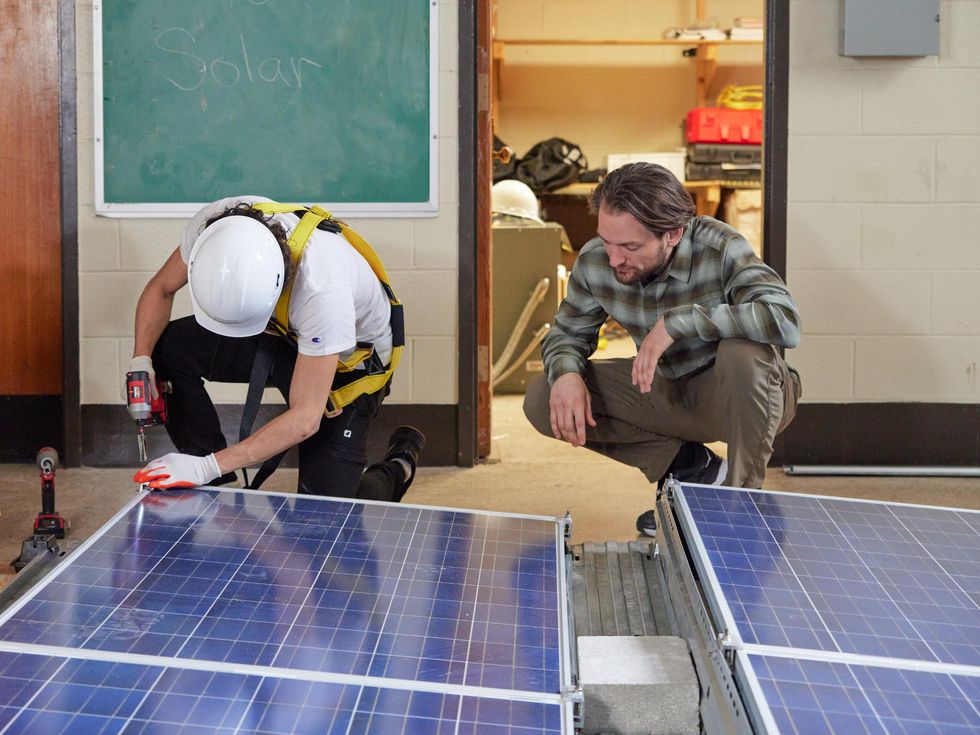
Frankford High School—where students can learn how to install solar panels, take field trips to solar sites, and can get paid summer internships. (Credit: Generation180)
Schools throughout the country are preparing students for one of the fastest-growing employment sectors: clean energy.
Pennsylvania has been ranked as a top state for solar employment growth since 2015, and school districts with their own solar arrays have a unique advantage. At Midd-West School District, for example, high school students taught fourth grade students about how the district’s solar array works this week as part of their STEM curriculum.
In 2020, the School District of Philadelphia launched “Bright Solar Futures,” one of the first solar career training programs in the country, as a three-year vocational program at Frankford High School. Students learn how to install solar panels, take field trips to solar sites, and can get paid summer internships.
“This program has enabled [students] to take control of their future in a way that will have a positive impact on their community and their environment,” Jordan Crolly, the School District of Philadelphia’s solar energy technology teacher, told Generation 180. “Having a meaningful career path to work towards that pays well has given many of the solar energy technology students a sense of direction and a reason to try in school.”
Room for more solar at Pennsylvania schools
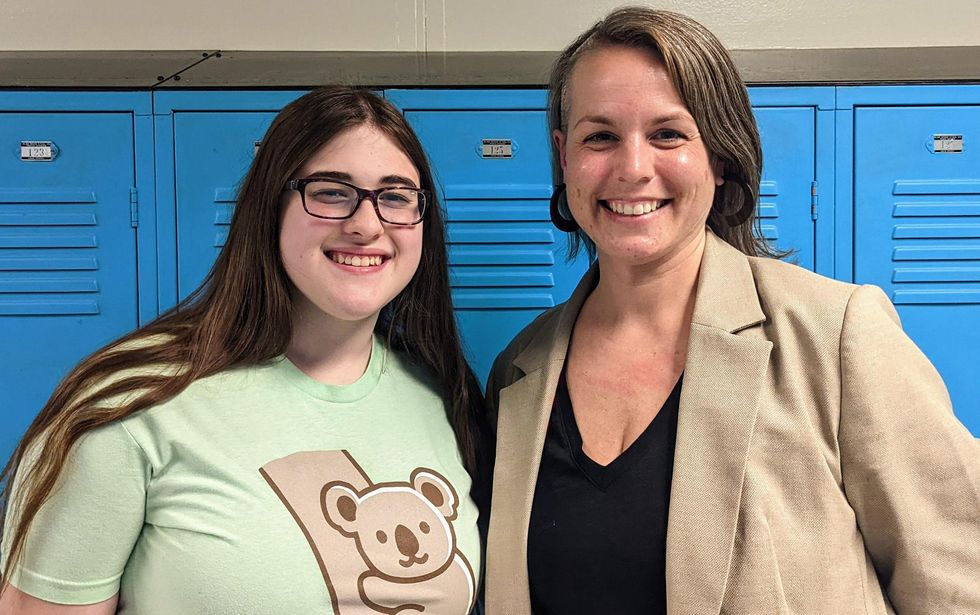
Abby Wypych and Lauren Palamara, pictured in the Woodland Hills School District administration building after giving their presentation to the school board. (Credit: Kristina Marusic)
When Generation180 published its 2020 report on solar energy at schools across the country, Pennsylvania ranked 25th in the nation for the number of K-12 schools with solar energy, lagging behind neighboring states like New York and Maryland.
“We want to help more Pennsylvania schools flip the switch to solar, especially in low-income school districts that will benefit the most from the savings,” Crooker said.
Pennsylvania has one of the largest public education systems in the U.S. with more than 1.7 million students. If Pennsylvania schools keep adopting solar energy at the same rate over the next five years, they’d sequester carbon dioxide from the atmosphere at a rate equal to covering the cities of Pittsburgh and Scranton with forests, according to Generation180’s report.
The report also determined that if every K-12 school in Pennsylvania installed an average-size solar energy system of 267 kilowatts, it would eliminate carbon dioxide emissions each year equivalent to closing 3.8 natural gas-fired power plants.
“Growing up in my generation and hearing everything bad about climate change, it kind of feels like you have no hope, like what’s the point,” Wypych said. “Having opportunities in school to make [climate advocacy] something fun honestly changes your perspective. Climate change is still this horrible thing, but we have hope because we can still change things. Just because we’re younger doesn’t mean we’re any less powerful.”
Banner photo credit: Generation180



